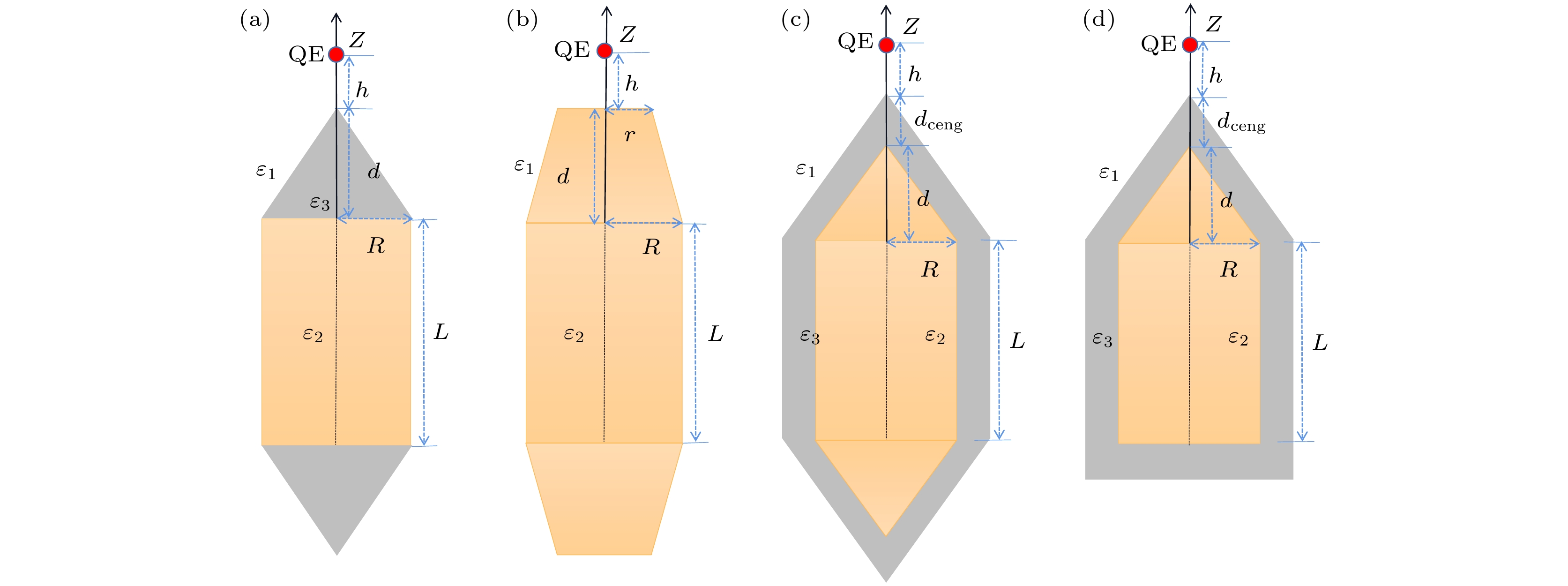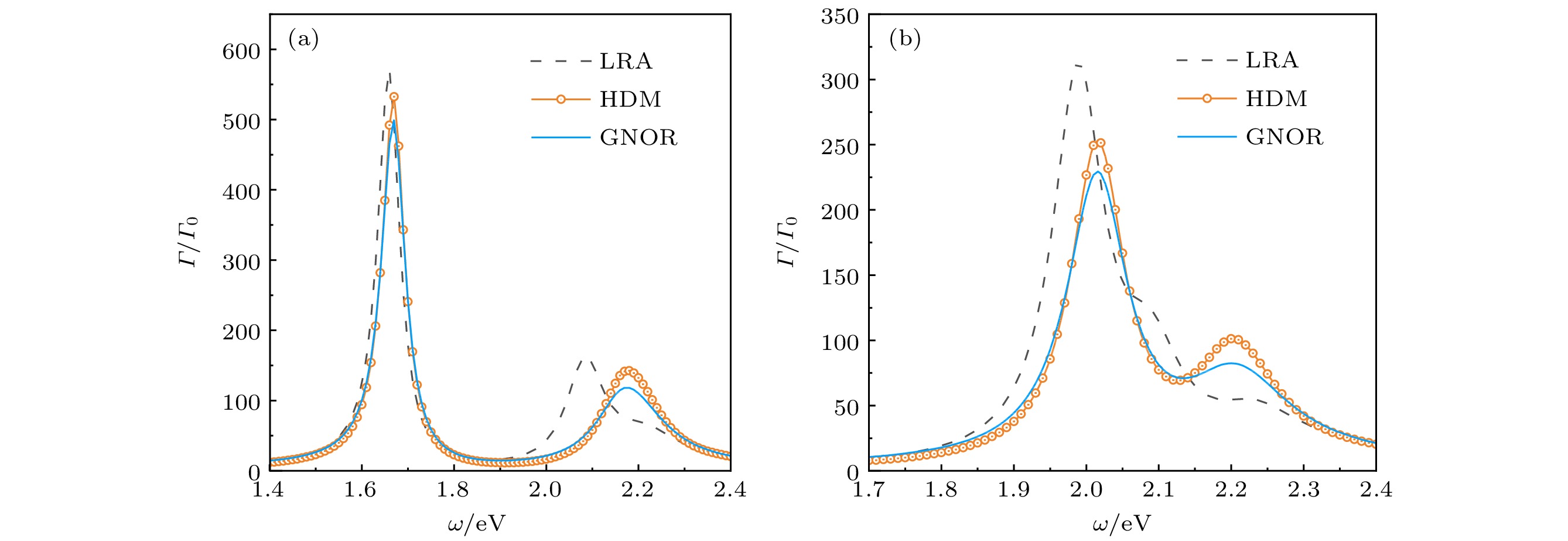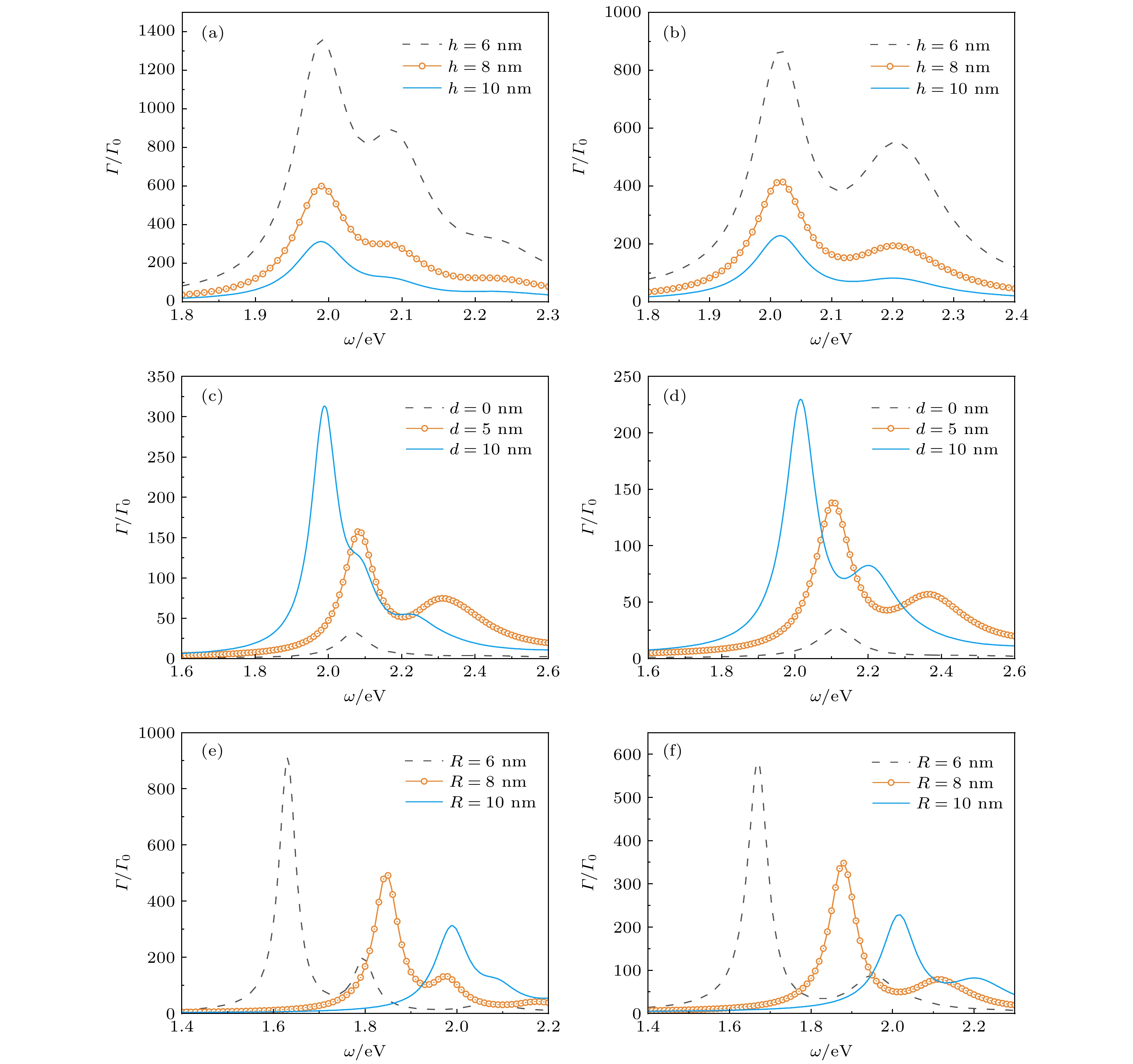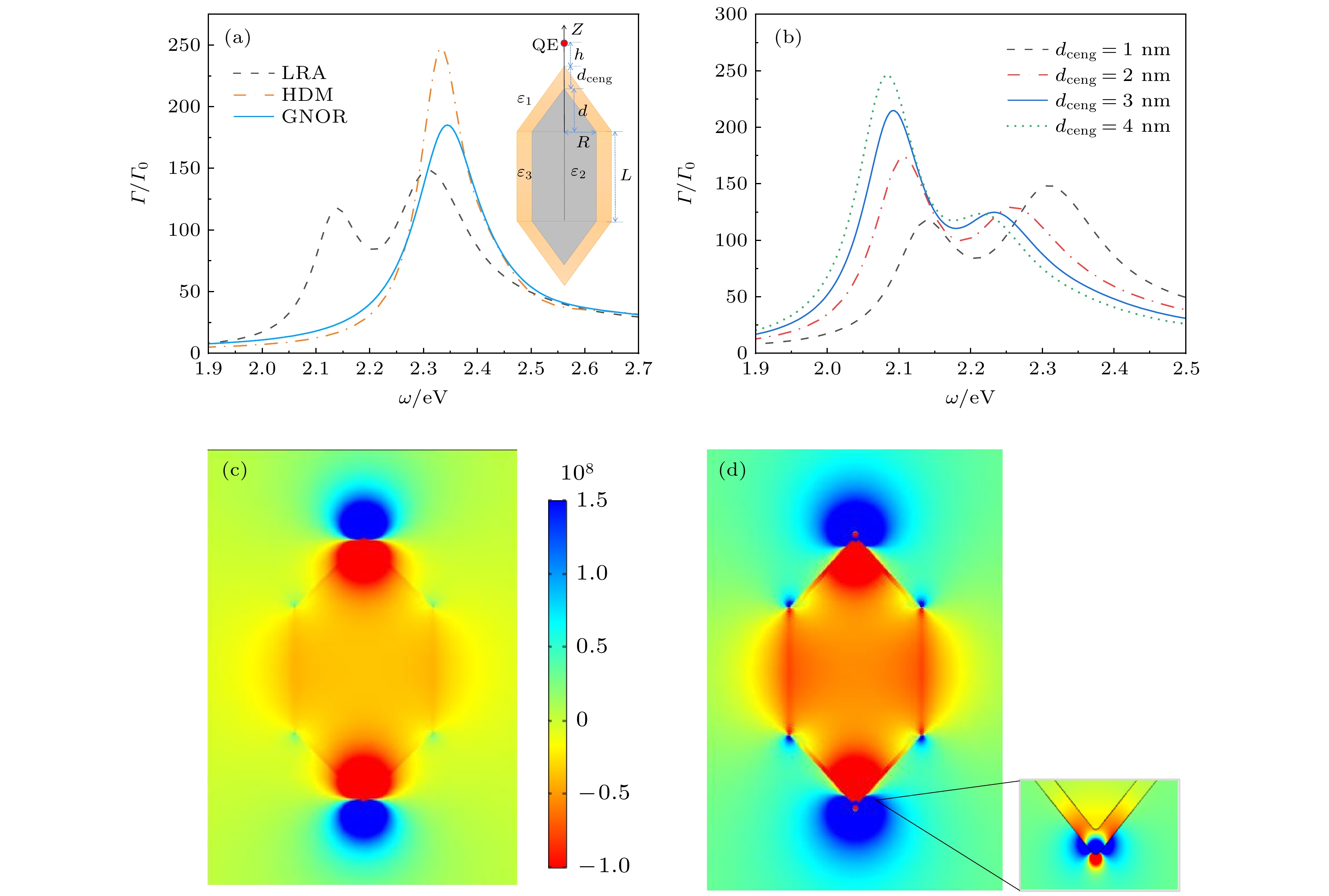-
Metal nanorods show excellent optical properties, since the plasmonic resonance frequency can be tuned by its aspect ratio and the optical field can be confined within a region of subwavelength, even within a nanometer region. It has the ability to flexibly modify the spontaneous emission properties of a nearby quantum emitter. However, it is unclear how the emission property changes when the metal nanorod has been deposited at the tips or coated on all sides with metal. In this work, the spontaneous emission enhancements of a two-level atom around a tailored nanorod with a wide variety of shapes, dimensions or materials are systematically investigated by the finite element method. Three different optical response models are adopted, including the classical local response approximation (LRA), the nonlocal hydrodynamic model (HDM), and the generalized nonlocal optical response model (GNOR). For a cylindrical nanorod with two endcaps, it is found that the resonance frequency shows large redshift and the emission enhancement peak increases as the endcap gradually changes from cone to cylinder of the same height. The resonance frequency shows small blueshift and the emission enhancement peak decreases slightly as the deposited metal of the conical endcaps changes from gold to silver. However, as the material of the cylinder also changes from gold to silver, becoming an all-silver nanostructure, an obvious blueshift can be detected at the resonance frequency and the emission enhancement peak rises sharply. For bimetal core-shell nanostructure, the shell can screen the surface plasmon of the core from being excited, and the plasmonic resonance associated with shell increases in proportion to the thickness of the shell. The emission enhancement peak for gold nanostructure appears to be blue-shifted when coated with silver. In contrast, it is red-shifted for silver nanostructure coated with gold.
-
Keywords:
- surface modification /
- spontaneous emission rate /
- metallic nanorod
[1] Schuller J A, Barnard E S, Cai W S, Jun Y C, White J S, Brongersma M L 2010 Nat. Mater. 9 193
 Google Scholar
Google Scholar
[2] Gramotnev D K, Bozhevolnyi S I 2010 Nat. Photonics 4 83
 Google Scholar
Google Scholar
[3] Baranov D G, Wersäll M, Cuadra J, Antosiewicz T J, Shegai T 2018 ACS Photonics 5 24
[4] Qian H, Zhu M, Wu Z, Jin R 2012 Acc. Chem. Res. 45 1470
 Google Scholar
Google Scholar
[5] Chen H J, Shao L, Li Q, Wang J F 2013 Chem. Soc. Rev. 42 2679
 Google Scholar
Google Scholar
[6] Jiang N, Zhuo X L, Wang J F 2017 Chem. Rev. 118 3054
[7] Gallinet B, Butet J, Martin O J F 2015 Laser Photonics Rev. 9 577
 Google Scholar
Google Scholar
[8] Rycenga M, Cobley C M, Zeng J, Li W Y, Moran C H, Zhang Q, Qin D, Xia Y N 2011 Chem. Rev. 111 3669
 Google Scholar
Google Scholar
[9] Bozhevolnyi S I, Volkov V S, Devaux E, Laluet J-Y, Ebbesen T W 2006 Nature 440 508
 Google Scholar
Google Scholar
[10] Lohse S E, Murphy C J 2013 Chem. Mater. 25 1250
 Google Scholar
Google Scholar
[11] Nusz G J, Marinakos S M, Curry A C, Dahlin A, Höök F, Wax A, Chilkoti A 2008 Anal. Chem. 80 984
 Google Scholar
Google Scholar
[12] Huang X H, Neretina S, El-Sayed M A 2009 Adv. Mater. 21 4880
 Google Scholar
Google Scholar
[13] Maltzahn G V, Park J H, Agrawal A, Bandaru N K, Das S K, Sailor M J, Bhatia S N 2009 Cancer Res. 69 3892
 Google Scholar
Google Scholar
[14] Dickerson E B, Dreaden E C, Huang X H, El-Sayed I H, Chu H, Pushpanketh S, McDonald J F, El-Sayed M A 2008 Cancer Lett. 269 57
 Google Scholar
Google Scholar
[15] Cao J, Sun T, Grattan K T V 2014 Sens. Actuators, B 195 332
 Google Scholar
Google Scholar
[16] He B S, Li J W 2019 Anal. Methods 11 1427
 Google Scholar
Google Scholar
[17] Kabashin A V, Evans P, Pastkovsky S, Hendren W, Wurtz G A, Atkinson R, Pollard R, Podolskiy V A, Zayats A V 2009 Nat. Mater. 8 867
 Google Scholar
Google Scholar
[18] Dorfmüller J, Vogelgesang R, Weitz R T, Rockstuhl C, Etrich C, Pertsch T, Lederer F, Kern K 2009 Nano Lett. 9 2372
 Google Scholar
Google Scholar
[19] Cubukcu E, Capasso F 2009 Appl. Phys. Lett. 95 201101
 Google Scholar
Google Scholar
[20] Agarwal G S 1974 Quantum Statistical Theories of Spontaneous Emission and Their Relation to Other Approaches (Berlin Heidelberg: Springer) pp1–128
[21] Tannoudji C C, Roc D J, Grynberg G 1997 Photons and Atoms: Introduction to Quantum Electrodynamics (New York: John Wiley & Sons) pp197–200
[22] Berestetskii V B, Pitaevskii L P, Lifshitz E M 1982 Quantum Electrodynamics (Vol. 4) (England: Butterworth-Heinemann) pp159–166
[23] Novotny L, Hulst N V 2011 Nat. Photonics 5 83
 Google Scholar
Google Scholar
[24] Wen S S, Tian M, Yang H, Xie S J, Wang X Y, Li Y, Liu J, Peng J Z, Deng K, Zhao H P, Huang Y G 2021 Chin. Phys. B 30 027801
 Google Scholar
Google Scholar
[25] Zhao Y J, Tian M, Wang X Y, Yang H, Zhao H P, Huang Y G 2018 Opt. Express 26 1390
 Google Scholar
Google Scholar
[26] Tian M, Huang Y G, Wen S S, Wang X Y, Yang H, Peng J Z, Zhao H P 2019 Phys. Rev. A 99 053844
 Google Scholar
Google Scholar
[27] Wen S S, Huang Y G, Wang X Y, Liu J, Li Y, Deng K, Quan X E, Yang H, Peng J Z, Zhao H P 2020 Opt. Express 28 6469
 Google Scholar
Google Scholar
[28] Miyazaki H T, Kurokawa Y 2006 Phys. Rev. Lett. 96 097401
 Google Scholar
Google Scholar
[29] Stockman M I 2004 Phys. Rev. Lett. 93 137404
 Google Scholar
Google Scholar
[30] Gersten J, Nitzan A 1980 J. Chem. Phys. 73 3023
 Google Scholar
Google Scholar
[31] Liu R M, Zhou Z K, Yu Y C, Zhang T W, Wang H, Liu G H, Wei Y M, Chen H J, Wang X H 2017 Phys. Rev. Lett. 118 237401
 Google Scholar
Google Scholar
[32] Tong L M, Wei H, Zhang S P, Li Z P, Xu H X 2013 Phys. Chem. Chem. Phys. 15 4100
 Google Scholar
Google Scholar
[33] Gordon R, Ahmed A 2018 ACS Photonics 5 4222
 Google Scholar
Google Scholar
[34] Benz F, Schmidt M K, Dreismann A, Chikkaraddy R, Zhang Y, Demetriadou A, Carnegie C, Ohadi H, Nijs B D, Esteban R, Aizpurua J, Baumberg J J 2016 Science 354 726
 Google Scholar
Google Scholar
[35] Li W C, Zhou Q, Zhang P, Chen X W 2021 Phys. Rev. Lett. 126 257401
 Google Scholar
Google Scholar
[36] Yang B, Chen G, Ghafoor A, Zhang Y F, Zhang Y, Zhang Y, Luo Y, Yang J L, Sandoghdar V, Aizpurua J, Dong Z C, Hou J G 2020 Nat. Photonics 14 693
 Google Scholar
Google Scholar
[37] 周强, 林树培, 张朴, 陈学文 2019 68 147104
 Google Scholar
Google Scholar
Zhou Q, Lin S P, Zhang P, Chen X W 2019 Acta Phys. Sin. 68 147104
 Google Scholar
Google Scholar
[38] Rosławska A, Neuman T, Doppagne B, Borisov A G, Romeo M, Scheurer F, Aizpurua J, Schull G 2022 Phys. Rev. X 12 011012
[39] Raza S, Bozhevolnyi S I, Wubs M, Mortensen N A 2015 J Phys. Condens. Matter 27 183204
 Google Scholar
Google Scholar
[40] Zhou Z K, Liu J F, Bao Y J, Wu L, Png C E, Wang X H, Qiu C W 2019 Prog. Quantum Electron. 65 1
 Google Scholar
Google Scholar
[41] Mortensen N A, Raza S, Wubs M, Søndergaard T, Bozhevolnyi S I 2014 Nat. Commun. 5 3809
 Google Scholar
Google Scholar
[42] Mortensen N A 2021 Nanophotonics 10 2563
 Google Scholar
Google Scholar
[43] Dung H T, Knöll L, Welsch D G 2002 Phys. Rev. A 65 043813
 Google Scholar
Google Scholar
[44] Sehmi H S, Langbein W, Muljarov E A 2017 Phys. Rev. B 95 115444
 Google Scholar
Google Scholar
[45] Raza S, Wubs M, Bozhevolnyi S I, Mortensen N A 2015 Opt. Lett. 40 839
 Google Scholar
Google Scholar
[46] Ciracì C, Urzhumov Y, Smith D R 2013 Opt. Express 21 9397
 Google Scholar
Google Scholar
[47] Aizpurua J, Bryant G W, Richter L J, Abajo F J G, Kelley B K, Mallouk T 2005 Phys. Rev. B 71 235420
 Google Scholar
Google Scholar
[48] Lu L H, Wang H S, Zhou Y H, Xi S Q, Zhang H J, Hu J W, Zhao B 2002 Chem. Commun. 2 144
-
图 1 模型结构示意图 (a) 双边尖端结构; (b) 双边圆台结构; (c) 双边尖端包覆结构; (d) 单边尖端包覆结构. 量子辐射体(
$ {\text{QE}} $ )位于纳米结构旋转对称轴上, 离金属表面距离为$ h $ , 背景的介电常数$ {\varepsilon _1} = 2.25 $ ,$ {\varepsilon _2} $ 和$ {\varepsilon _3} $ 为金或者银的局域介电函数Figure 1. Schematic diagrams: (a) Cylindrical nanorod with two conical endcaps; (b) cylindrical nanorod with two truncated conical endcaps; (c) bimetal core-shell nanostructure that has the same shape as that in panel (a); (d) bimetal core-shell nanostructure that has the shape of a cylindrical nanorod with a single conical endcap. A quantum emitter (QE) is located on height
$ h $ above the metal surface. The relative permittivity for the background is$ {\varepsilon _1} = 2.25 $ .$ {\varepsilon _2} $ and$ {\varepsilon _3} $ indicate the relative permittivity for two different metals, such as silver or gold.图 2 不同长度双边尖端金纳米柱中的自发辐射增强谱
$\varGamma /{\varGamma _0}$ (a)$L = 40{\text{ nm}}$ ; (b)$L = 20\text{ nm}$ Figure 2. Emission enhancement spectra
$\varGamma /{\varGamma _0}$ for nanostructures of two different length: (a)$L = 40{\text{ nm}}$ ; (b)$L = 20\text{ nm}$ . The schematic diagram for the nanostructure is shown in Fig. 1(a).图 3 不同几何参数下的自发辐射增强谱
$\varGamma /{\varGamma _0}$ (a), (b) 量子点离金属表面的距离$ h $ ; (c), (d) 尖端高度$ d $ ; (e), (f) 纳米柱半径$ R $ . 左栏为LRA, 右栏为GNORFigure 3. Emission enhancement spectra
$\varGamma /{\varGamma _0}$ at different geometrical parameters: (a), (b) different$ {\text{QE}} $ -surface distances$ h $ ; (c), (d) different cone heights$ d $ ; (e), (f) different nanorod radius$ R $ . The left column is for the LRA and the right column is for the GNOR.图 4 双边圆台结构的端面半径对自发辐射增强
$\varGamma /{\varGamma _0}$ 特性的影响 (a) LRA; (b) GNOR. 其中,$r$ 为圆台端面半径, 当$r = 0{\text{ nm}}$ 时, 该结构为双边尖端结构, 当$r = 10{\text{ nm}}$ 时为圆柱结构, 当$r = 2, 4, 6{\text{ nm}}$ 时为圆台结构Figure 4. Emission enhancement spectra
$\varGamma /{\varGamma _0}$ for different radius$r$ at the endcaps (see Fig. 1(b)): (a) LRA; (b) GNOR. When$r = 0{\text{ nm}}$ , the endcaps are of a cone shape. When$r = 10{\text{ nm}}$ , the nanostructure becomes a nanorod. When$r$ is between them, the nanostructure is a cylindrical nanorod with two truncated conical endcaps.图 5 双边尖端结构中, 不同金属对自发辐射增强
$\varGamma /{\varGamma _0}$ 特性的影响. 纳米结构的材料为 (a) 金, (b) 金柱身银尖端, (c) 银, (d) 银柱身金尖端Figure 5. Emission enhancement spectra
$\varGamma /{\varGamma _0}$ for nanostructure (see the insets) composed of different metal materials. The materials are (a) gold, (b) gold cylindrical nanorod and two silver conical endcaps, (c) silver, (d) silver cylindrical nanorod and two gold conical endcaps.图 6 旋转对称轴上, 实等效模体积
${\rm Re} \left\{ {1/{V_k}} \right\}$ 随着金属表面距离$z$ 的变化情况. 插图为纳米结构中最低阶模式的$E_z $ 分量. 黑色点划线(Ag)和蓝色实线(Au)分别代表银和金双边尖端纳米结构, 红色虚线(Ag-Au-Ag)代表银尖端金纳米柱结构, 绿色点线(Au-Ag-Au)代表金尖端银纳米柱结构Figure 6. The effective real mode volume
${\rm Re} \left\{ {1/{V_k}} \right\}$ as a function of the distance$z$ between the QE and the metal surface. The inset is for the$E_z $ component of the fundamental quasi normal mode. The black dash-doted line (Ag) and the blue solid line (Au) stand for silver and gold, respectively. The red dashed line (Ag-Au-Ag) stands for the gold cylinder with silver endcaps. The green dotted line (Au-Ag-Au) stands for the silver nanorod with gold endcaps.图 7 银包覆金结构中的自发辐射增强
$\varGamma /{\varGamma _0}$ 特性 (a)${d_{{\text{ceng}}}} = 1{\text{ nm}}$ ; (b) LRA下,${d_{{\text{ceng}}}} = 1, {\text{ }}2, {\text{ }}3, {\text{ }}4{\text{ nm}}$ ; (c)与(d)分别为图(a)结构中的两个表面等离激元准正则模式的$E_z $ 分量Figure 7. Emission enhancement spectra
$\varGamma /{\varGamma _0}$ for a gold nanostructure coated with silver (see the inset in (a)): (a)${d_{{\text{ceng}}}} = 1{\text{ nm}}$ ; (b)${d_{{\text{ceng}}}} = 1, {\text{ }}2, {\text{ }}3, {\text{4 nm}}$ under the LRA; (c) and (d) are for the$E_z $ component of the two quasi normal modes on the cross section.图 8 金包覆银结构中的自发辐射增强
$\varGamma /{\varGamma _0}$ 特性 (a)${d_{{\text{ceng}}}} = 1{\text{ nm}}$ ; (b) LRA下,${d_{{\text{ceng}}}} = 1, {\text{ }}2, {\text{ }}3, {\text{ }}4{\text{ nm}}$ ; (c)与(d)分别为图(a)结构中的两个表面等离激元准正则模式的$E_z $ 分量Figure 8. Emission enhancement spectra
$\varGamma /{\varGamma _0}$ for a silver nanostructure coated with gold (see the inset in (a)): (a)${d_{{\text{ceng}}}} = 1{\text{ nm}}$ ; (b) different shell thicknesses with${d_{{\text{ceng}}}} = 1, {\text{ }}2, {\text{ }}3, {\text{ }}4{\text{ nm}}$ ; (c) and (d) are for the$E_z $ component of the two quasi normal modes on the cross section.图 9 银包覆金单边尖端结构中的自发辐射增强
$\varGamma /{\varGamma _0}$ 特性. 结构示意图如左图所示, 橙色圆圈代表银包覆双边金尖端结构中的结果, 即图7(a)中的结果 (a) LRA; (b) GNORFigure 9. The enhancement of the spontaneous emission rate
$\varGamma /{\varGamma _0}$ for nanostructure composed of gold core coated with silver. The schematic diagram is on the left, where the core is composed of a cylindrical nanorod with a single conical endcap. The orange line with dots represents the results shown in Fig. 7(a) where there are two cones on both ends of the cylindrical nanorod: (a) LRA; (b) GNOR. -
[1] Schuller J A, Barnard E S, Cai W S, Jun Y C, White J S, Brongersma M L 2010 Nat. Mater. 9 193
 Google Scholar
Google Scholar
[2] Gramotnev D K, Bozhevolnyi S I 2010 Nat. Photonics 4 83
 Google Scholar
Google Scholar
[3] Baranov D G, Wersäll M, Cuadra J, Antosiewicz T J, Shegai T 2018 ACS Photonics 5 24
[4] Qian H, Zhu M, Wu Z, Jin R 2012 Acc. Chem. Res. 45 1470
 Google Scholar
Google Scholar
[5] Chen H J, Shao L, Li Q, Wang J F 2013 Chem. Soc. Rev. 42 2679
 Google Scholar
Google Scholar
[6] Jiang N, Zhuo X L, Wang J F 2017 Chem. Rev. 118 3054
[7] Gallinet B, Butet J, Martin O J F 2015 Laser Photonics Rev. 9 577
 Google Scholar
Google Scholar
[8] Rycenga M, Cobley C M, Zeng J, Li W Y, Moran C H, Zhang Q, Qin D, Xia Y N 2011 Chem. Rev. 111 3669
 Google Scholar
Google Scholar
[9] Bozhevolnyi S I, Volkov V S, Devaux E, Laluet J-Y, Ebbesen T W 2006 Nature 440 508
 Google Scholar
Google Scholar
[10] Lohse S E, Murphy C J 2013 Chem. Mater. 25 1250
 Google Scholar
Google Scholar
[11] Nusz G J, Marinakos S M, Curry A C, Dahlin A, Höök F, Wax A, Chilkoti A 2008 Anal. Chem. 80 984
 Google Scholar
Google Scholar
[12] Huang X H, Neretina S, El-Sayed M A 2009 Adv. Mater. 21 4880
 Google Scholar
Google Scholar
[13] Maltzahn G V, Park J H, Agrawal A, Bandaru N K, Das S K, Sailor M J, Bhatia S N 2009 Cancer Res. 69 3892
 Google Scholar
Google Scholar
[14] Dickerson E B, Dreaden E C, Huang X H, El-Sayed I H, Chu H, Pushpanketh S, McDonald J F, El-Sayed M A 2008 Cancer Lett. 269 57
 Google Scholar
Google Scholar
[15] Cao J, Sun T, Grattan K T V 2014 Sens. Actuators, B 195 332
 Google Scholar
Google Scholar
[16] He B S, Li J W 2019 Anal. Methods 11 1427
 Google Scholar
Google Scholar
[17] Kabashin A V, Evans P, Pastkovsky S, Hendren W, Wurtz G A, Atkinson R, Pollard R, Podolskiy V A, Zayats A V 2009 Nat. Mater. 8 867
 Google Scholar
Google Scholar
[18] Dorfmüller J, Vogelgesang R, Weitz R T, Rockstuhl C, Etrich C, Pertsch T, Lederer F, Kern K 2009 Nano Lett. 9 2372
 Google Scholar
Google Scholar
[19] Cubukcu E, Capasso F 2009 Appl. Phys. Lett. 95 201101
 Google Scholar
Google Scholar
[20] Agarwal G S 1974 Quantum Statistical Theories of Spontaneous Emission and Their Relation to Other Approaches (Berlin Heidelberg: Springer) pp1–128
[21] Tannoudji C C, Roc D J, Grynberg G 1997 Photons and Atoms: Introduction to Quantum Electrodynamics (New York: John Wiley & Sons) pp197–200
[22] Berestetskii V B, Pitaevskii L P, Lifshitz E M 1982 Quantum Electrodynamics (Vol. 4) (England: Butterworth-Heinemann) pp159–166
[23] Novotny L, Hulst N V 2011 Nat. Photonics 5 83
 Google Scholar
Google Scholar
[24] Wen S S, Tian M, Yang H, Xie S J, Wang X Y, Li Y, Liu J, Peng J Z, Deng K, Zhao H P, Huang Y G 2021 Chin. Phys. B 30 027801
 Google Scholar
Google Scholar
[25] Zhao Y J, Tian M, Wang X Y, Yang H, Zhao H P, Huang Y G 2018 Opt. Express 26 1390
 Google Scholar
Google Scholar
[26] Tian M, Huang Y G, Wen S S, Wang X Y, Yang H, Peng J Z, Zhao H P 2019 Phys. Rev. A 99 053844
 Google Scholar
Google Scholar
[27] Wen S S, Huang Y G, Wang X Y, Liu J, Li Y, Deng K, Quan X E, Yang H, Peng J Z, Zhao H P 2020 Opt. Express 28 6469
 Google Scholar
Google Scholar
[28] Miyazaki H T, Kurokawa Y 2006 Phys. Rev. Lett. 96 097401
 Google Scholar
Google Scholar
[29] Stockman M I 2004 Phys. Rev. Lett. 93 137404
 Google Scholar
Google Scholar
[30] Gersten J, Nitzan A 1980 J. Chem. Phys. 73 3023
 Google Scholar
Google Scholar
[31] Liu R M, Zhou Z K, Yu Y C, Zhang T W, Wang H, Liu G H, Wei Y M, Chen H J, Wang X H 2017 Phys. Rev. Lett. 118 237401
 Google Scholar
Google Scholar
[32] Tong L M, Wei H, Zhang S P, Li Z P, Xu H X 2013 Phys. Chem. Chem. Phys. 15 4100
 Google Scholar
Google Scholar
[33] Gordon R, Ahmed A 2018 ACS Photonics 5 4222
 Google Scholar
Google Scholar
[34] Benz F, Schmidt M K, Dreismann A, Chikkaraddy R, Zhang Y, Demetriadou A, Carnegie C, Ohadi H, Nijs B D, Esteban R, Aizpurua J, Baumberg J J 2016 Science 354 726
 Google Scholar
Google Scholar
[35] Li W C, Zhou Q, Zhang P, Chen X W 2021 Phys. Rev. Lett. 126 257401
 Google Scholar
Google Scholar
[36] Yang B, Chen G, Ghafoor A, Zhang Y F, Zhang Y, Zhang Y, Luo Y, Yang J L, Sandoghdar V, Aizpurua J, Dong Z C, Hou J G 2020 Nat. Photonics 14 693
 Google Scholar
Google Scholar
[37] 周强, 林树培, 张朴, 陈学文 2019 68 147104
 Google Scholar
Google Scholar
Zhou Q, Lin S P, Zhang P, Chen X W 2019 Acta Phys. Sin. 68 147104
 Google Scholar
Google Scholar
[38] Rosławska A, Neuman T, Doppagne B, Borisov A G, Romeo M, Scheurer F, Aizpurua J, Schull G 2022 Phys. Rev. X 12 011012
[39] Raza S, Bozhevolnyi S I, Wubs M, Mortensen N A 2015 J Phys. Condens. Matter 27 183204
 Google Scholar
Google Scholar
[40] Zhou Z K, Liu J F, Bao Y J, Wu L, Png C E, Wang X H, Qiu C W 2019 Prog. Quantum Electron. 65 1
 Google Scholar
Google Scholar
[41] Mortensen N A, Raza S, Wubs M, Søndergaard T, Bozhevolnyi S I 2014 Nat. Commun. 5 3809
 Google Scholar
Google Scholar
[42] Mortensen N A 2021 Nanophotonics 10 2563
 Google Scholar
Google Scholar
[43] Dung H T, Knöll L, Welsch D G 2002 Phys. Rev. A 65 043813
 Google Scholar
Google Scholar
[44] Sehmi H S, Langbein W, Muljarov E A 2017 Phys. Rev. B 95 115444
 Google Scholar
Google Scholar
[45] Raza S, Wubs M, Bozhevolnyi S I, Mortensen N A 2015 Opt. Lett. 40 839
 Google Scholar
Google Scholar
[46] Ciracì C, Urzhumov Y, Smith D R 2013 Opt. Express 21 9397
 Google Scholar
Google Scholar
[47] Aizpurua J, Bryant G W, Richter L J, Abajo F J G, Kelley B K, Mallouk T 2005 Phys. Rev. B 71 235420
 Google Scholar
Google Scholar
[48] Lu L H, Wang H S, Zhou Y H, Xi S Q, Zhang H J, Hu J W, Zhao B 2002 Chem. Commun. 2 144
Catalog
Metrics
- Abstract views: 5814
- PDF Downloads: 69
- Cited By: 0
























 DownLoad:
DownLoad:



























































